Autodesk Releases New Computer-Aided Design Software AliasStudio 2008
If you are intrigued by the latest computer aided design software from Autodesk, download a personal learning edition for free.
Latest News
July 31, 2007
By Mark Clarkson
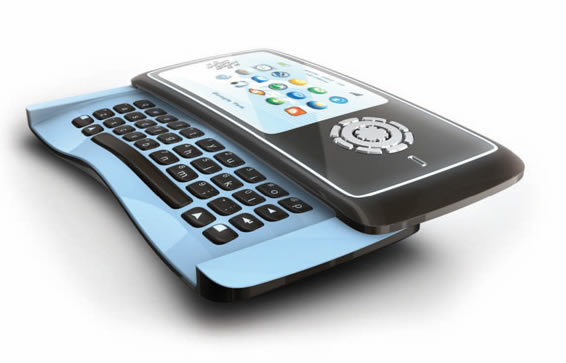 AliasStudio’s hardware shading provides realistic rendering, complete with reflections and shadows, in real time. |
AliasStudio 2008 is a bit of an odd duck. It’s not really a CAD application like, say, Inventor or SolidWorks. Nor is it a 3D modeling and rendering application like Maya or 3ds Max. It occupies the rarified space between those applications, with considerable overlap in both directions. Who, then, is it for? If you’re a designer, it’s for you.
Designers work in that same, in-between space: somewhere between the nuts and bolts of CAD, and the shine of product “beauty shots.” You start your designs, not with a precisely defined arc on a reference plane, or a sub-divided 3D mesh, but with a sketch. AliasStudio understands.
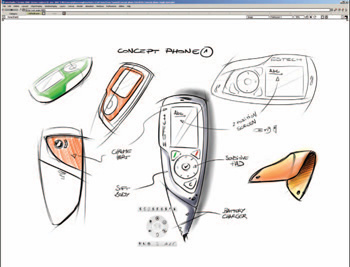 AliasStudio supports tablets, so you can draw freehand or on a flat canvas that can be moved around in 3Dspace. These sample product sketches were all drawn in AliasStudio. |
Sketch my Design Up
Let’s start with sketching. AliasStudio actually lets you do it, not by messing about with splines, but by drawing with pencils and markers and airbrushes, albeit virtual ones. AliasStudio offers you a complete, if basic, set of painting, drawing, and sketching tools. How many other 3D applications can say that?
Your sketches can be “freehand,” or you can draw on a flat canvas that you can move around in 3D space to use as a guide for the actual design. AliasStudio’s new predictive strokes recognize your strokes to help you sketch perfect curves, lines, and circles, even with a mouse.
AliasStudio supports tablets and, if you’re sketching on the computer, you really want a tablet. Sadly, I’m suffering from a rare glitch that keeps my Wacom tablet from working properly. At the time of this writing, Autodesk is trying to run it down.
What About “Real” CAD?
Drawing is all well and good, but what about real work? Yes, Alias has all your modeling tools — from 2D curves to 3D meshes and surfaces. Fillets and chamfers and flanges and rounds. You can model a sheet metal box or a chrome-and-plastic media player.
You can also interactively transform and twist entire objects, what AliasStudio calls “Dynamic Shape Modeling;” quickly try out a half dozen design iterations of your new cell phone, or tooth brush, by squeezing this or bending that.
You can organize your designs by placing different elements in different layers — curves, surfaces, front side, back side, and so on. Layers can be independently hidden or revealed.
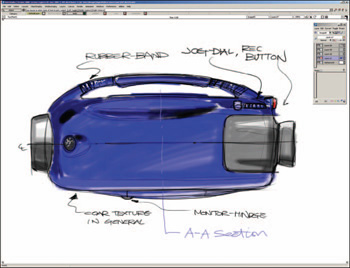 Another product sketch drawn in AliasStudio.You can use virtual pencils,markers, or airbrushes. |
AliasStudio includes a modeling history of sorts, but it lacks the kind of fully editable history tree you’d get from a parametric CAD modeler.
Shelve that Command
AliasStudio has lots of tools. The Palette makes them all available at once but, though you can open and close sections, it can be a bit overwhelming.
To help you through your design day a little more easily, AliasStudio offers “Shelves.” Shelves are basically custom tool palettes. AliasStudio’s shelves can be customized, and you can build your own unique shelves, complete with grouped tools and cascading menus, to fit your particular workflow, or different segments of it.
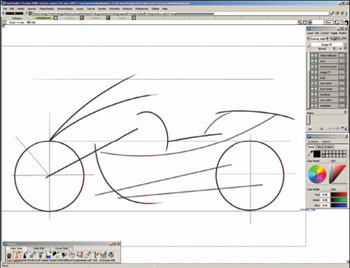 Predictivestrokes:AliasStudio can recognize what you’re trying to draw and create your strokes as precise lines, curves, and ellipses, even with a mouse. |
Consider this: a common modeling operation — for creating a button — might combine curve and line creation, curve editing, moving and scaling transformations, and surface operations such as flange or revolve. In the Palette, these are all in different sections — Transform, Curve Edit, Surfaces, etc. But your “Button Modeling” shelf can include all of these, in a logical sequence.
Interface This
AliasStudio also makes accessing your most common tools and commands easier with a pop-up navigation menu similar to Maya’s. When drawing and painting, a touch of the spacebar brings up a similar pop-up menu to allow you to adjust your brush size, shape, color, rotation, and so on without leaving your sketch to sort through menus.
I liked AliasStudio’s interface overall; it’s pretty clean and places the proper emphasis on letting you see your work. There are, however, a lot of little annoyances scattered throughout.
AliasStudio’s cursor, for example, is almost always the same shape — an arrow and box. Selecting objects? Arrow and box. Placing new cones in a scene? Arrow and box. Drawing a spline curve? Arrow and box. A little more feedback here would be nice.
The Go button, used to commit actions (e.g., trim) doesn’t come to the top, so it can get hidden under palettes, leaving you wondering how to proceed.
Buttons in the shelves and palettes are labeled, but the labels are far too long to fit. My Surfaces tools, for example, reads “form blible flan round lange crv netmb surbe surf.” Fortunately, hovering your mouse over a tool will (usually) get you a tool tip and a description.
The lack of support for standard Windows key commands (Alt+F for the File menu, Ctrl+S to save), and the non-standard way number input fields are handled means reaching from mouse to keyboard and back again more often than I like.
The interface is highly customizable, so some of these problems can be gotten around one way or another. In the meantime, it gives Autodesk something to work on for the next release.
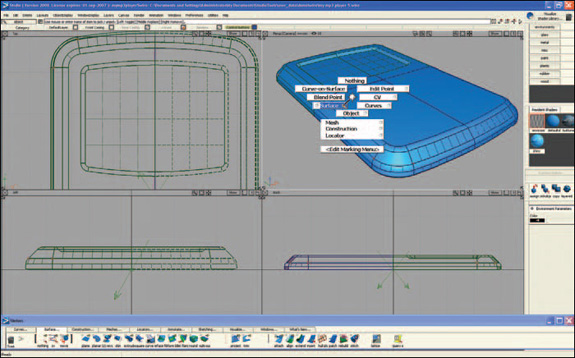 The AliasStudio workspace.Pressing Ctrl+Shift pops up handy, customizable “marking menus”’ for quick access to selections, transformations, and display options. |
Is That A Render?
The thing that really floored me is the quality of AliasStudio’s hardware rendering. It is stunning. Good enough, resolution issues aside, to go straight from screen shot to print.
Reflections and specularity? Well, sure. But how about reflective ground planes, per-pixel bump and displacement mapping, self-shadowing, and ambient occlusion? How about HDRI scene lighting? They’re all there and if you don’t know what these all mean, it’s because they haven’t generally been available in CAD applications. Suffice it to say that, taken together, they all help make your product look very realistic. In real time. Wow.
Can you overwhelm the hardware renderer with super-giant models? Sure. It also helps that products designed in AliasStudio will generally be made of metal and plastic and glass, which are relatively easy to render, but even so, AliasStudio’s real-time presentation is terrific. You may not think you need realistic, real-time rendering but, once you’ve had it, you’ll never want to go back.
All in all, AliasStudio is a really great program that addresses the needs of the industrial designer better than any other application I’ve seen. If you’re intrigued, you can download the Personal Learning Edition, free, from Autodesk.More Info:
Autodesk AliasStudio 2008
Autodesk, Inc.
San Rafael, CA
MSRP: $24,995
Contributing Editor Mark Clarkson, a.k.a. “the Wichita By-Lineman,” has been writing about all manner of computer stuff for years. An expert in computer animation and graphics, his newest book is “Photoshop Elements by Example.” Visit him on the web at markclarkson.com or send e-mail about this article to DE-Editorsmailto:[email protected].
Subscribe to our FREE magazine, FREE email newsletters or both!
Latest News
About the Author
Mark ClarksonContributing Editor Mark Clarkson is Digital Engineering’s expert in visualization, computer animation, and graphics. His newest book is Photoshop Elements by Example. Visit him on the web at MarkClarkson.com or send e-mail about this article to [email protected].
Follow DE





